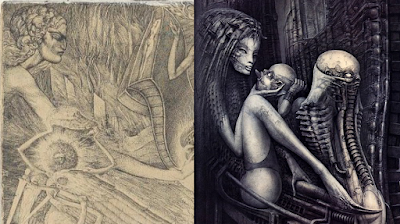a) Passage Temple Life references idol in double page spread from Jack Kirby's The Demon?
The
wall that serves as a monorail has a break in the center which opens
up to show a zip and a penis filled with babies.
It becomes reminiscent
of the horned head of the idol shown in The Demon by Jack Kirby, with a
divide in the centre of the wide horns and a generalised phallic shape
sticking out of the top of it.
Perhaps the legs of the woman have
something to do with the diagonal claw shapes entangled with the horns
 |
| Passage Temple Life (1975) |
 |
| Double page spread from Jack Kirby's The Demon (approx 1972-1973) |
 |
| Giger's Passage Temple Life and detail from sculpture in the from The Demon. |
 | ||
| Giger's Passage Temple Life and detail from sculpture in the from The Demon. \ |
 |
| Detail from from sculpture in the pages in Jack Kirby's The Demon |
b) References Ernst Fuch's Triumph of the Unicorn (started 1952)?
 |
| Ernst Fuchs' Triumph Of The Unicorn (1952) |
On the 24th of April 2017, I suddenly realised that Ernst Fuchs "Triumph of the Unicorn" was referenced in Giger's Passage Temple (Life) (work 261) (1974).
Perhaps you could almost generally say was the starting point for the painting
Giger takes the rupture in the side of the building and uses it in his own painting.
This other piece of architecture inside, Giger takes the central part and turns it into a phallus.
The bottom and sides of the piece of striped architecture become transformed into the zip.
The crisscrossing sticks become transformed into the suspenders worn by the lowest babies.
The line of ribbing beneath the curved wall floating in the air becomes transformed into the ribbing up the body of a biomechanic humanoid with a bald head.
c) See: References Lee Brown Coye's 1973 illustration of a skinned lemur?
 |
| Lee Brown Coye's drawing and right side of Giger's Passage Temple Life (1974) painting |




No comments:
Post a Comment